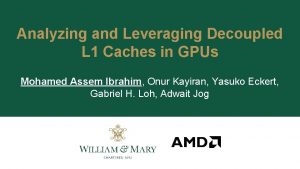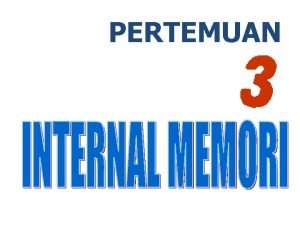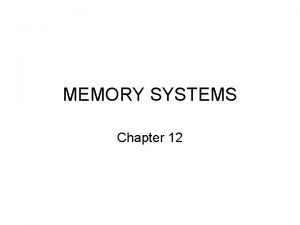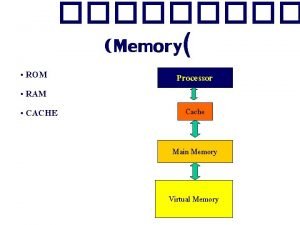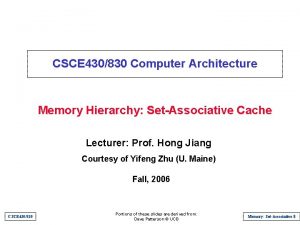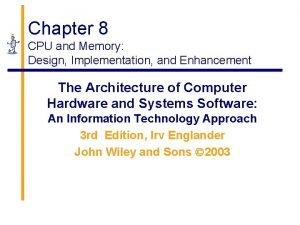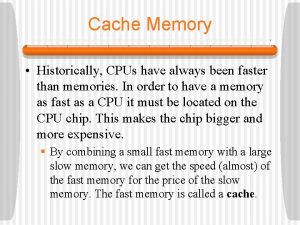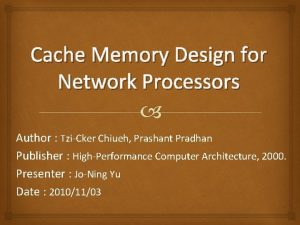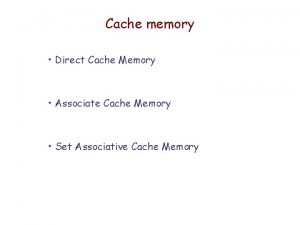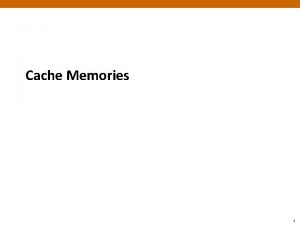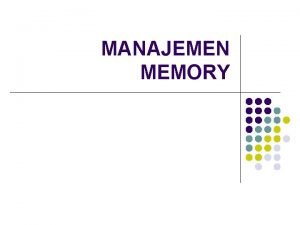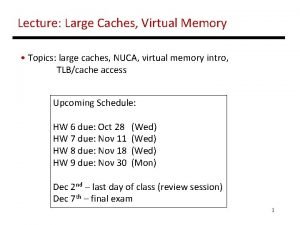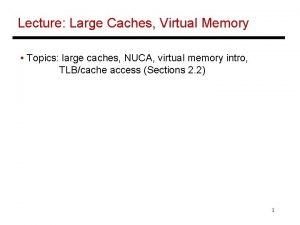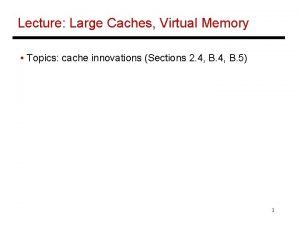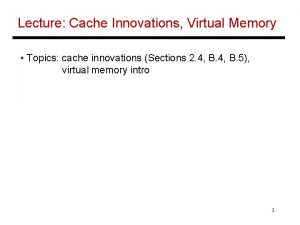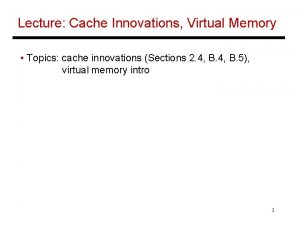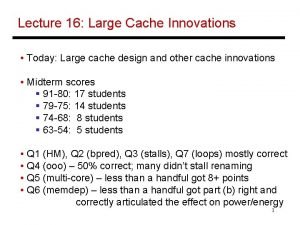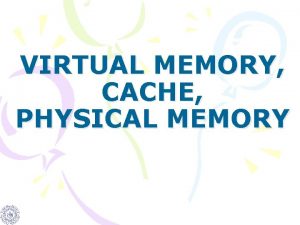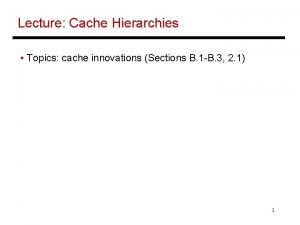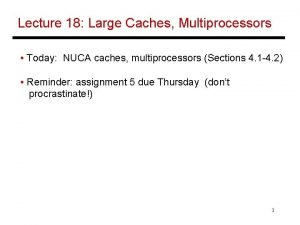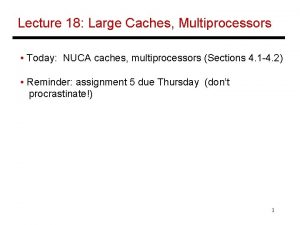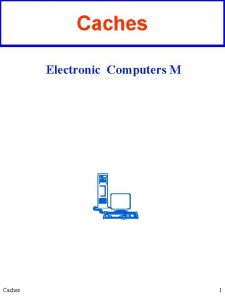Lecture Large Caches Virtual Memory Topics cache innovations

















- Slides: 17

Lecture: Large Caches, Virtual Memory • Topics: cache innovations (Sections 2. 4, B. 5) 1

Techniques to Reduce Cache Misses • Victim caches • Better replacement policies – pseudo-LRU, NRU • Prefetching, cache compression 2

Victim Caches • A direct-mapped cache suffers from misses because multiple pieces of data map to the same location • The processor often tries to access data that it recently discarded – all discards are placed in a small victim cache (4 or 8 entries) – the victim cache is checked before going to L 2 • Can be viewed as additional associativity for a few sets that tend to have the most conflicts 3

Replacement Policies • Pseudo-LRU: maintain a tree and keep track of which side of the tree was touched more recently; simple bit ops • NRU: every block in a set has a bit; the bit is made zero when the block is touched; if all are zero, make all one; a block with bit set to 1 is evicted 4

Prefetching • Hardware prefetching can be employed for any of the cache levels • It can introduce cache pollution – prefetched data is often placed in a separate prefetch buffer to avoid pollution – this buffer must be looked up in parallel with the cache access • Aggressive prefetching increases “coverage”, but leads to a reduction in “accuracy” wasted memory bandwidth • Prefetches must be timely: they must be issued sufficiently in advance to hide the latency, but not too early (to avoid 5 pollution and eviction before use)

Stream Buffers • Simplest form of prefetch: on every miss, bring in multiple cache lines • When you read the top of the queue, bring in the next line Sequential lines L 1 Stream buffer 6

Stride-Based Prefetching • For each load, keep track of the last address accessed by the load and a possibly consistent stride • FSM detects consistent stride and issues prefetches incorrect init steady correct incorrect (update stride) correct PC correct tag prev_addr stride state correct trans no-pred incorrect (update stride) 7

Intel Montecito Cache Two cores, each with a private 12 MB L 3 cache and 1 MB L 2 Naffziger et al. , Journal of Solid-State Circuits, 2006 8

Intel 80 -Core Prototype – Polaris Prototype chip with an entire die of SRAM cache stacked upon the cores 9

Shared Vs. Private Caches in Multi-Core • What are the pros/cons to a shared L 2 cache? P 1 P 2 P 3 P 4 L 1 L 1 L 2 L 2 L 2 10

Shared Vs. Private Caches in Multi-Core • Advantages of a shared cache: § Space is dynamically allocated among cores § No waste of space because of replication § Potentially faster cache coherence (and easier to locate data on a miss) • Advantages of a private cache: § small L 2 faster access time § private bus to L 2 less contention 11

UCA and NUCA • The small-sized caches so far have all been uniform cache access: the latency for any access is a constant, no matter where data is found • For a large multi-megabyte cache, it is expensive to limit access time by the worst case delay: hence, non-uniform cache architecture 12

Large NUCA Issues to be addressed for Non-Uniform Cache Access: • Mapping CPU • Migration • Search • Replication 13

Shared NUCA Cache Core 0 L 1 D$ Core 1 L 1 I$ L 1 D$ L 2 $ Core 4 L 1 D$ L 1 I$ L 1 D$ L 2 $ Core 5 L 1 I$ Core 2 L 1 I$ L 2 $ L 1 I$ Core 3 L 1 D$ L 2 $ Core 6 L 1 D$ L 1 I$ A single tile composed of a core, L 1 caches, and a bank (slice) of the shared L 2 cache Core 7 L 1 D$ L 2 $ Memory Controller for off-chip access L 1 I$ L 2 $ The cache controller forwards address requests to the appropriate L 2 bank and handles coherence operations

Virtual Memory • Processes deal with virtual memory – they have the illusion that a very large address space is available to them • There is only a limited amount of physical memory that is shared by all processes – a process places part of its virtual memory in this physical memory and the rest is stored on disk • Thanks to locality, disk access is likely to be uncommon • The hardware ensures that one process cannot access the memory of a different process 15

Address Translation • The virtual and physical memory are broken up into pages 8 KB page size Virtual address virtual page number Translated to phys page number 13 page offset Physical address physical page number 13 page offset Physical memory 16

Title • Bullet 17
 Virtual memory and cache memory
Virtual memory and cache memory Analyzing and leveraging decoupled l1 caches in gpus
Analyzing and leveraging decoupled l1 caches in gpus L caches
L caches Virtual memory in memory hierarchy consists of
Virtual memory in memory hierarchy consists of Karakteristik memori
Karakteristik memori Karakteristik dari cache memory
Karakteristik dari cache memory Direct map cache
Direct map cache Cache rom
Cache rom Direct mapping advantage and disadvantage
Direct mapping advantage and disadvantage Cache vs memory
Cache vs memory Set associative mapping in cache memory
Set associative mapping in cache memory Cache vs memory
Cache vs memory Cache memory is faster than
Cache memory is faster than Cache memory design
Cache memory design Cache memory adalah
Cache memory adalah Cache read operation flowchart
Cache read operation flowchart Cache memory organization
Cache memory organization Contoh memori register
Contoh memori register

